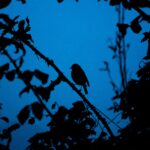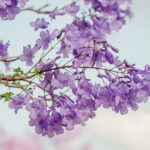Are you ready to dive deep into the mesmerizing world of the Indigo Plant? In this article, we will uncover the captivating secrets and extraordinary potential of this remarkable plant species. As we embark on this journey, get ready to explore its historical significance, practical applications, and its role in revolutionizing the textile industry. But that’s not all – we will also delve into the fascinating realm of ecological farming practices and how the Indigo Plant has the power to contribute to sustainable agriculture. So, fasten your seatbelts and prepare to be amazed by the wonders of the Indigo Plant!

Indigo Plant
Indigofera, a remarkable genus of flowering plants belonging to the pea family Fabaceae, has gained significant attention for its wide distribution in tropical and subtropical regions around the world. With over 750 species and diverse variations, the Indigo Plant offers intriguing potential as a perennial crop. Two particular species, Indigofera tinctoria and Indigofera suffruticosa, have played a pivotal role in the dye industry through the production of the iconic indigo dye. But that’s not all – this plant has so much more to offer!
Unraveling Nature’s Palette: Indigo’s Colorful Contributions
The captivating Indigo Plant serves as a vital food source for the larvae of certain Lepidoptera species, showcasing its ecological significance. Beyond its role in the ecosystem, its unique fruit, a long and cylindrical legume pod, offers an intriguing avenue for exploration. By categorizing the pericarp (the tissue surrounding the seeds) into different types based on thickness, we uncover the potential for specialized cultivation in polyculture systems. The Indigo Plant’s flowering morphologies, fruit types, and pericarp thickness all contribute to its versatility and suitability for cultivation.
“Delve into the rich tapestry of Indigo Plant’s characteristics, and unlock its potential as a multifaceted ally in sustainable agriculture.”
From Colonial Cash Crop to Ecological Farming Champion
In addition to being a renowned dyestuff, the Indigo Plant played a prominent role as a cash crop during colonial America. This historical significance highlights the plant’s resilience and economic value. Notably, Indigofera suffruticosa paved the way for the synthesis of aniline, a chemical serving as the foundation for numerous dyes. This breakthrough underscores the plant’s immense potential for innovation and advancement in the realm of natural dye production. Moreover, the Indigo Plant has been utilized in traditional batik fabric dyeing in Indonesia, illustrating its cultural importance.
“Journey through the annals of history and uncover the Indigo Plant’s indelible mark on both the past and the future of textile production.”
Sustainable Farming: Indigo Plant as an Eco-Warrior
Embracing a commitment to environmental preservation, the Indigo Plant emerges as an ally for sustainable farming practices. Its role in ecological farming extends beyond dye production, as it offers an alternative to synthetic additives in agriculture. Through its ability to fix nitrogen in the soil and promote sustainable farming, the Indigo Plant becomes a natural contributor to a healthier ecosystem. Furthermore, the plant’s potential as a perennial crop showcases its long-term benefits, reducing the need for continuous replanting.
“Witness the Indigo Plant’s transformation from mere dye producer to a champion of ecological farming practices, revolutionizing the agricultural landscape.”
Innovation Beyond Borders: The Vastness of the Indigo World
The genus Indigofera encompasses a diverse array of species, each harboring unique characteristics and potential applications. From the elegant Indigofera argentea to the mysterious Indigofera atriceps and the exotic Indigofera bainesii, this expansive world of Indigo Plants beckons exploration and discovery. By delving into the intricacies of each species, we unravel the extraordinary possibilities in the field of natural dyes, textiles, and sustainable farming practices.
“Embark on a journey across continents and unearth the hidden treasures within the vast Indigo Plant family, inspiring innovation and creativity.”
As a seasoned horticulturist, my passion for sustainable farming and my dedication to preserving the environment drive me to unveil the captivating Indigo Plant. Through my extensive research and expertise, I aim to shed light on its textile contributions, ecological farming potential, and remarkable qualities. Let us venture together into the enchanting world of the Indigo Plant, immersing ourselves in its rich history and promising future in the realm of textiles, natural dyes, and sustainable agriculture.
Indigo is a color that has been captivating people for centuries. From its representation in ancient artwork to its prominent role in modern fashion, there are so many fascinating facts about indigo that you might not know. If you’re curious about the history, cultural significance, or even the science behind this rich hue, then you’re in luck! Visit our page on facts about indigo to uncover a treasure trove of information and satisfy your curiosity. With captivating stories and intriguing insights, this page is sure to keep you hooked from start to finish. So don’t wait any longer – click the link and dive into the mesmerizing world of indigo!
The Indigo Plant, with its rich history and fascinating properties, has captivated people for centuries. Imagine diving into the intriguing past of this extraordinary plant and uncovering the secrets of its vibrant hues. Discover the mesmerizing tale behind the history of the indigo plant and how it played a significant role in shaping cultures worldwide. Curious about the properties that make indigo plant so sought-after? Delve into the depths of its amazing characteristics, from its natural dyeing abilities to its potential health benefits. Uncover all this and more in our comprehensive article on the history of indigo plant and the properties it possesses. So why wait? Take a deep dive into the mystical world of indigo and learn why this plant has fascinated generations. Click here to explore the fascinating history of the indigo plant: history of indigo plant. To uncover the remarkable properties of the indigo plant, follow this link: properties of indigo plant.
FAQ
Q: What is the Indigo Plant?
A: The Indigo Plant is a member of the Indigofera genus, which includes over 750 species of flowering plants in the pea family Fabaceae. It is widely distributed in tropical and subtropical regions around the world.
Q: Are there different types of Indigo Plants?
A: Yes, the Indigofera genus has diverse species with unique characteristics. Some notable species include Indigofera tinctoria and Indigofera suffruticosa, which are used to produce the dye indigo. Other species, such as Indigofera argentea, Indigofera atriceps, and Indigofera bainesii, contribute to the genus’s wide range of variation.
Q: What are the practical applications of the Indigo Plant?
A: The Indigo Plant has significant contributions to textiles and natural dyes. Its dye-producing species have been traditionally used for fabric dyeing, including in traditional batik in Indonesia. Additionally, the Indigo Plant shows potential for ecologically-friendly farming practices as a perennial crop.
Q: Can Indigofera species be cultivated in polyculture systems?
A: Yes, different species of Indigofera have distinctive flowering morphologies, fruit types, and pericarp thickness. This variability allows for potential artificial selection and cultivation in polyculture systems, promoting biodiversity and sustainable agricultural practices.
Q: What is the historical significance of the Indigo Plant?
A: The Indigo Plant played a significant role in the dyeing industry and was an important cash crop in colonial America. It is also noteworthy that the chemical aniline, the precursor to many important dyes, was first synthesized from Indigofera suffruticosa.
















